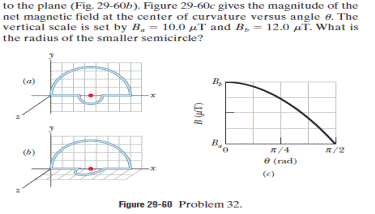
Concept explainers
GO The current-carrying wire loop in Fig. 29-6a lies all in one plane and consists of a semicircle of radius 10.0 cm. a smaller semicircle with the same center, and two radial lengths. The smaller semicircle is rotated out of that plane by angle θ, until it is perpendicular to the (Fig. 29-60b). Figure 29-60c give the magnitude of the net magnetic field at the center of curvature versus angle θ. The vertical scale is set by Ba = 10.0 μT and Bb = 12.0 μT . What is the radius of the smaller semicircle?

Figure 29-60 Problem 32.
Want to see the full answer?
Check out a sample textbook solution
Chapter 29 Solutions
FUND. OF PHYSICS (LL)-W/WILEY+NEXTGEN(2)
Additional Science Textbook Solutions
Chemistry: Structure and Properties (2nd Edition)
Human Biology: Concepts and Current Issues (8th Edition)
College Physics: A Strategic Approach (3rd Edition)
Cosmic Perspective Fundamentals
Campbell Biology: Concepts & Connections (9th Edition)
Campbell Biology (11th Edition)
- A long, solid, cylindrical conductor of radius 3.0 cm carries a current of 50 A distributed uniformly over its cross-section. Plot the magnetic field as a function of the radial distance r from the center of the conductor.arrow_forwardAssume the region to the right of a certain plane contains a uniform magnetic field of magnitude 1.00 mT and the field is zero in the region to the left of the plane as shown in Figure P22.71. An electron, originally traveling perpendicular to the boundary plane, passes into the region of the field. (a) Determine the time interval required for the electron to leave the field-filled region, noting that the electrons path is a semicircle. (b) Assuming the maximum depth of penetration into the field is 2.00 cm, find the kinetic energy of the electron.arrow_forwardA long, straight, horizontal wire carries a left-to-right current of 20 A. If the wire is placed in a uniform magnetic field of magnitude 4.0105 T that is directed vertically downward, what is tire resultant magnitude of the magnetic field 20 cm above the wire? 20 cm below the wire?arrow_forward
- A mass spectrometer (Fig. 30.40, page 956) operates with a uniform magnetic field of 20.0 mT and an electric field of 4.00 103 V/m in the velocity selector. What is the radius of the semicircular path of a doubly ionized alpha particle (ma = 6.64 1027 kg)?arrow_forwardIs B constant in magnitude for points that lie on a magnetic field line?arrow_forwardA magnetic field directed into the page changes with time according to B = 0.030 0t2 + 1.40, where B is in teslas and t is in seconds. The field has a circular cross section of radius R = 2.50 cm (see Fig. P23.28). When t = 3.00 s and r2 = 0.020 0 m, what are (a) the magnitude and (b) the direction of the electric field at point P2?arrow_forward
- When the current through a circular loop is 6.0 A, the magnetic field at its center is 2.0104 T. What is the radius of the loop?arrow_forward27 In Fig. 29-55, two long straight wires (shown in cross section) carry the currents i = 30.0 mA and iz = 40.0 mA directly out of the page. They are equal distances from the origin, where they set up a magnetic field B. To what value must current be changed in order to rotate B 20.0° clockwise? -x- Figure 29-55 Problem 27.arrow_forwardThe magnetic field ♬ is defined as B = B, (î+2j- 4k) T and the velocity of the test charge in this field is v = v₁ (3î − j + 2k) m/s . What is the electric field when the net force exerted on the test charge becomes zero at certain point in the given magnetic field? (a) v, B. (31-23-82) N/C (b) -v, B. (3i+j-sk) N/C (c) -v, B. (14j+7k) N/C (d) v, B. (14j+7k) N/Carrow_forward
- *33 SSM ILW Figure 29-61 shows a cross section of a long thin ribbon of width w = 4.91 cm that is carrying a uniformly distributed total current -d- : i = 4.61 µA into the page. In unit-vec- tor notation, what is the magnetic field B at a point Pin the plane of the х****х*-X Figure 29-61 Problem 33. ribbon at a distance d = 2.16 cm from its edge? (Hint: Imagine the ribbon as being constructed from many long, thin, parallel wires.)arrow_forwardFigure 28-41 shows a rectangular, 25-turn coil of wire, 10.0 cm by 5.0 cm. It carries a current of 0.50 A and is hinged along one long side. It is mounted in the xy plane, at angle 6 = 30° to the direction of a uniform magnetic field of magnitude 0.40 T. Find the torque acting on the coil about the hinge line. ( j + k) N·m + Hinge line B Fig.28-41 Xarrow_forwardb) If the radius of the cylindrical conductor is 2.00 mm and = 60 A, find the magnitude of the magnetic field far from the center of the wire for a distance of 1.00 mm.arrow_forward

 Principles of Physics: A Calculus-Based TextPhysicsISBN:9781133104261Author:Raymond A. Serway, John W. JewettPublisher:Cengage Learning
Principles of Physics: A Calculus-Based TextPhysicsISBN:9781133104261Author:Raymond A. Serway, John W. JewettPublisher:Cengage Learning Physics for Scientists and Engineers: Foundations...PhysicsISBN:9781133939146Author:Katz, Debora M.Publisher:Cengage Learning
Physics for Scientists and Engineers: Foundations...PhysicsISBN:9781133939146Author:Katz, Debora M.Publisher:Cengage Learning


